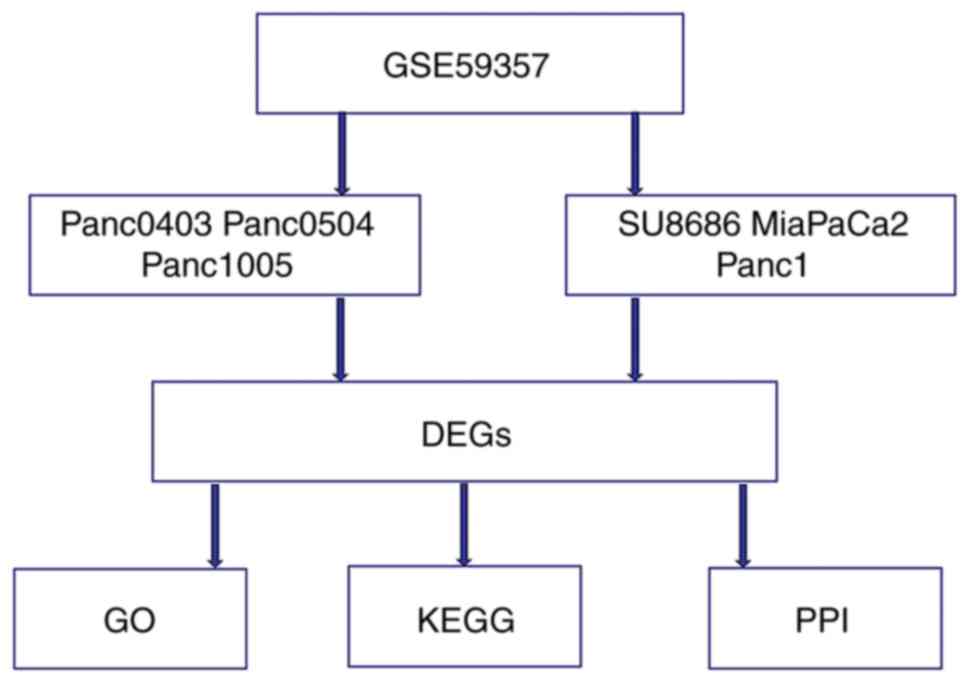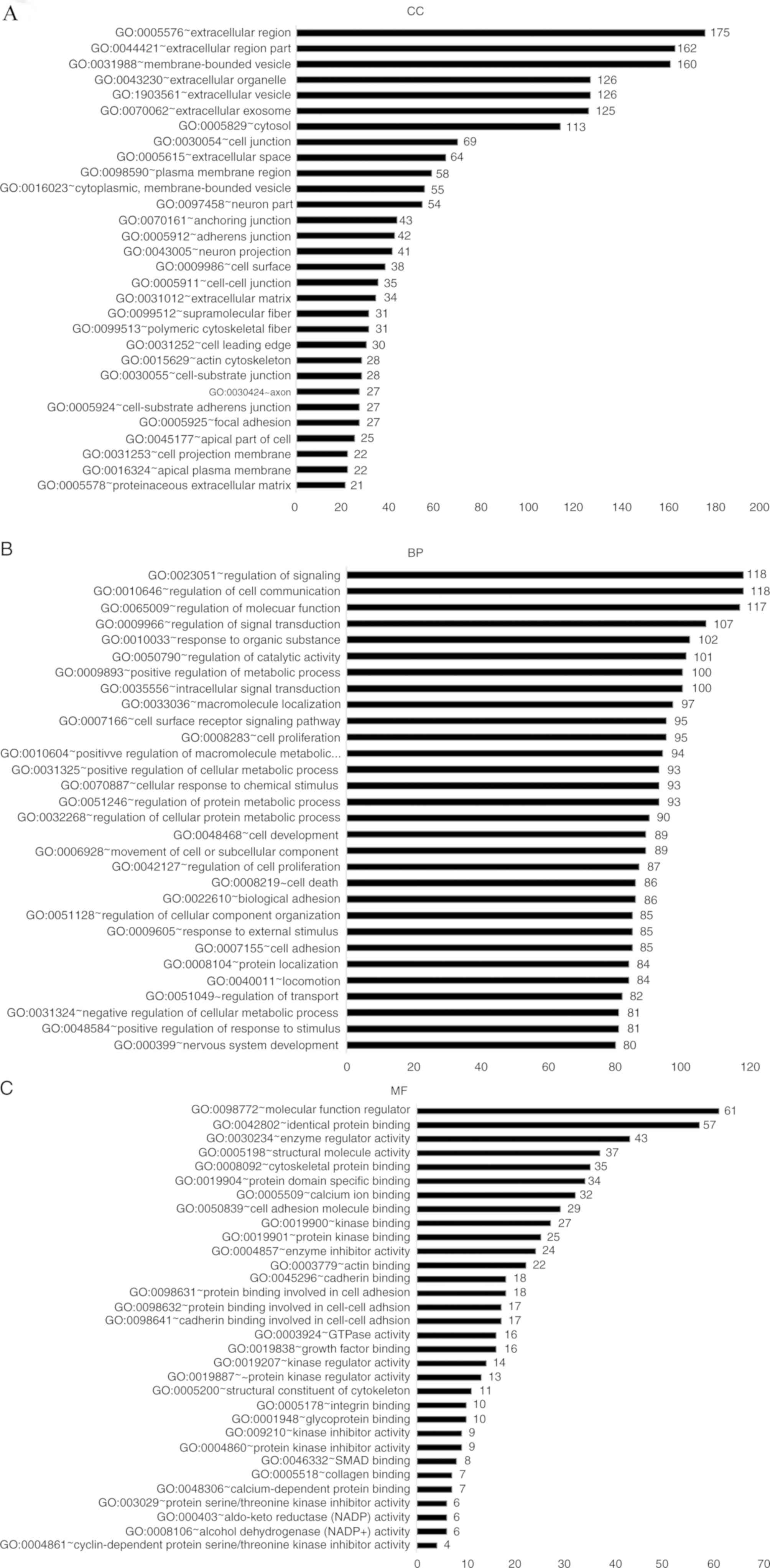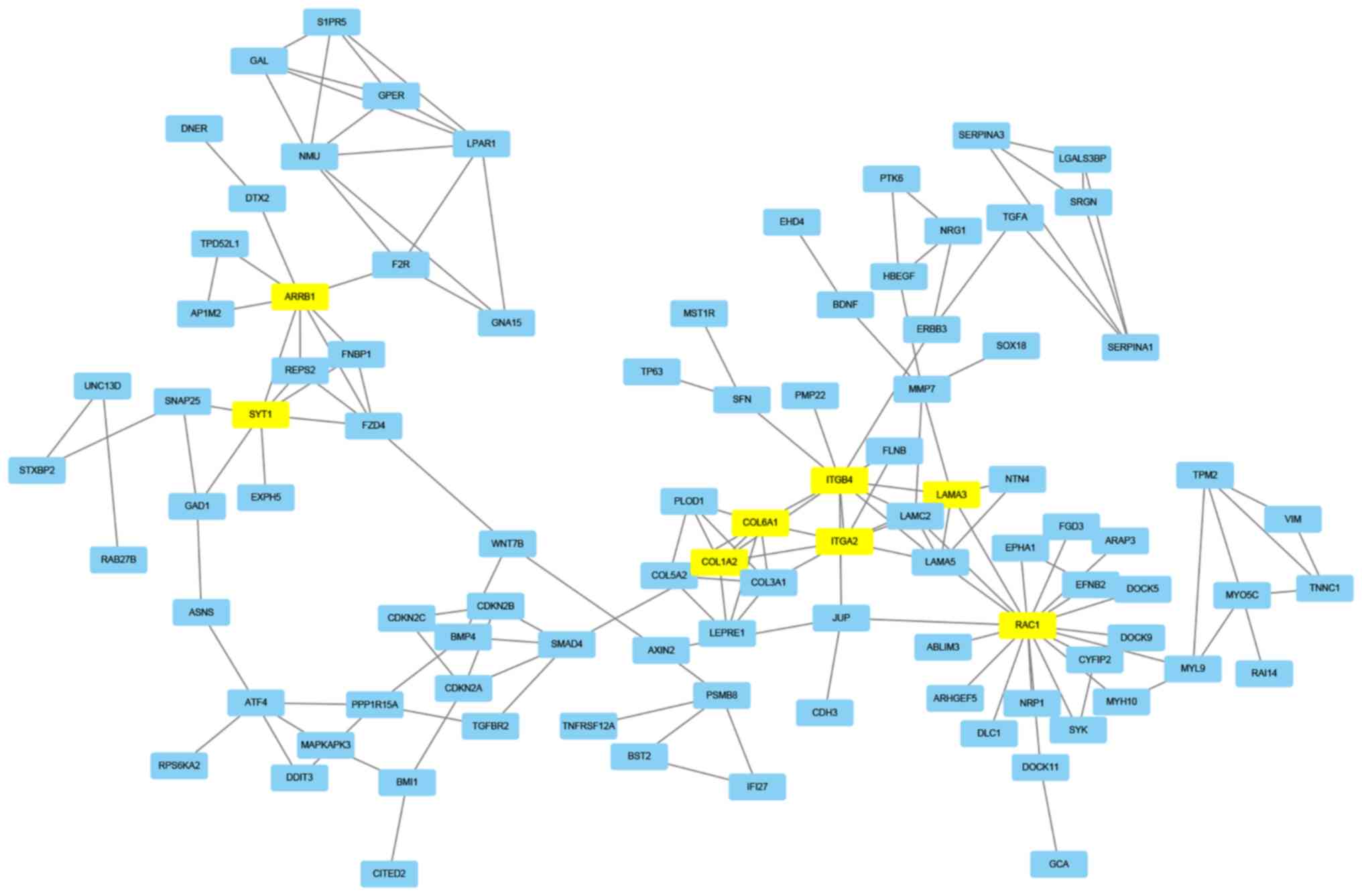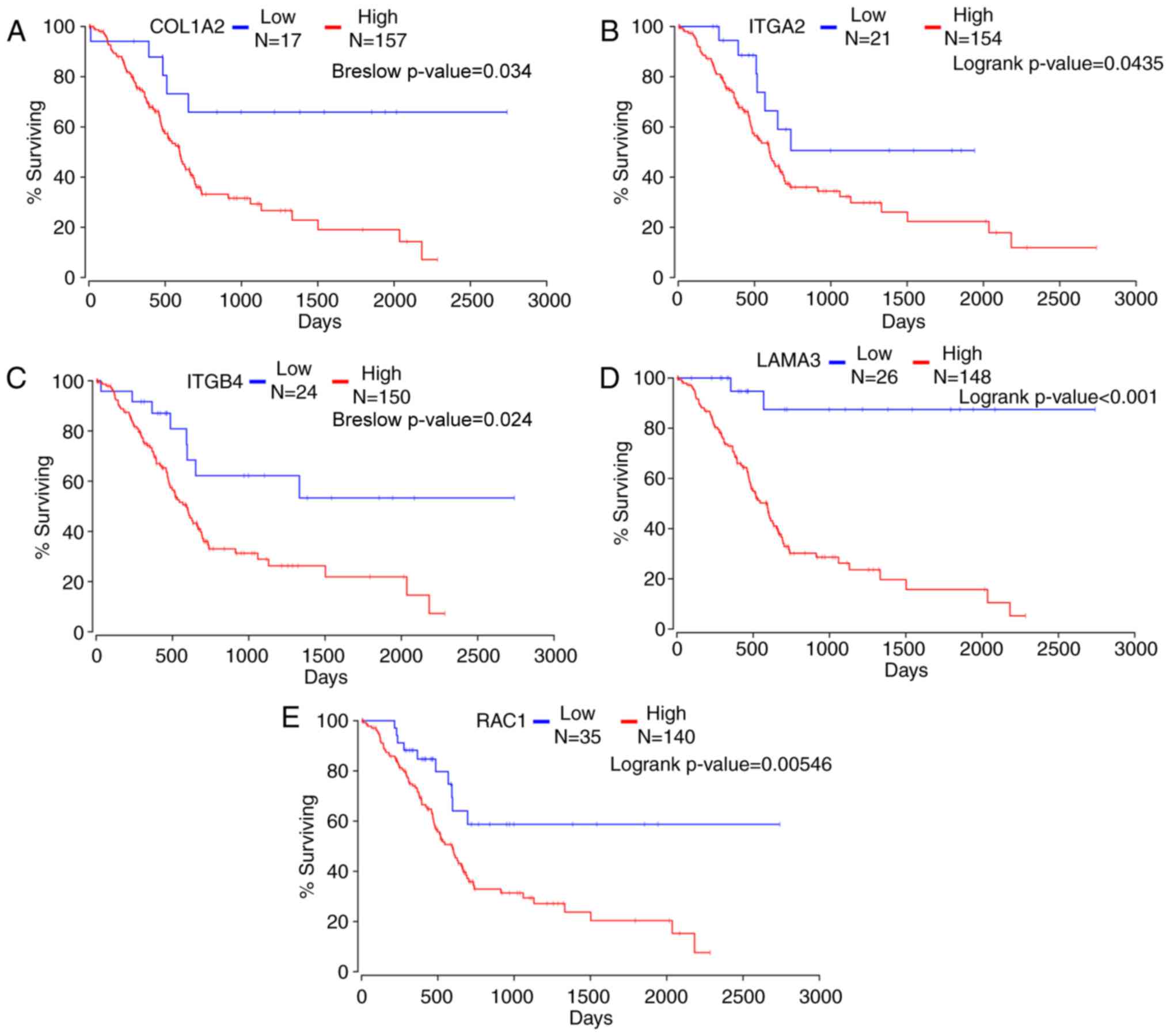|
1
|
Jemal A, Bray F, Center MM, Ferlay J, Ward
E and Forman D: Global cancer statistics. CA Cancer J Clin.
61:69–90. 2011. View Article : Google Scholar : PubMed/NCBI
|
|
2
|
Siegel R, Naishadham D and Jemal A: Cancer
statistics, 2013. CA Cancer J Clin. 63:11–30. 2013. View Article : Google Scholar : PubMed/NCBI
|
|
3
|
Lau MK, Davila JA and Shaib YH: Incidence
and survival of pancreatic head and body and tail cancers: A
population-based study in the United States. Pancreas. 39:458–462.
2010. View Article : Google Scholar : PubMed/NCBI
|
|
4
|
Quaresma M, Coleman MP and Rachet B:
40-year trends in an index of survival for all cancers combined and
survival adjusted for age and sex for each cancer in England and
Wales, 1971–2011: A population-based study. Lancet. 385:1206–1218.
2015. View Article : Google Scholar : PubMed/NCBI
|
|
5
|
Reya T, Morrison SJ, Clarke MF and
Weissman IL: Stem cells, cancer, and cancer stem cells. Nature.
414:105–111. 2001. View
Article : Google Scholar : PubMed/NCBI
|
|
6
|
Shah NP, Tran C, Lee FY, Chen P, Norris D
and Sawyers CL: Overriding imatinib resistance with a novel ABL
kinase inhibitor. Science. 305:399–401. 2004. View Article : Google Scholar : PubMed/NCBI
|
|
7
|
Keating GM: Dasatinib: A review in chronic
myeloid leukaemia and Ph+ acute lymphoblastic leukaemia. Drugs.
77:85–96. 2017. View Article : Google Scholar : PubMed/NCBI
|
|
8
|
Summy JM and Gallick GE: Src family
kinases in tumor progression and metastasis. Cancer Metastasis Rev.
22:337–358. 2003. View Article : Google Scholar : PubMed/NCBI
|
|
9
|
Koon HK, Chan PS, Wong RN, Wu ZG, Lung ML,
Chang CK and Mak NK: Targeted inhibition of the EGFR pathways
enhances Zn-BC-AM PDT-induced apoptosis in well-differentiated
nasopharyngeal carcinoma cells. J Cell Biochem. 108:1356–1363.
2009. View Article : Google Scholar : PubMed/NCBI
|
|
10
|
Wang X, Wilson MJ, Slaton JW, Sinha AA,
Ewing SL and Pei D: Increased aggressiveness of human prostate PC-3
tumor cells expressing cell surface localized membrane type-1
matrix metalloproteinase (MT1-MMP). J Androl. 30:259–274. 2009.
View Article : Google Scholar : PubMed/NCBI
|
|
11
|
Chien W, Sun QY, Lee KL, Ding LW, Wuensche
P, Torres-Fernandez LA, Tan SZ, Tokatly I, Zaiden N, Poellinger L,
et al: Activation of protein phosphatase 2A tumor suppressor as
potential treatment of pancreatic cancer. Mol Oncol. 9:889–905.
2015. View Article : Google Scholar : PubMed/NCBI
|
|
12
|
Gnoni A, Marech I, Silvestris N, Vacca A
and Lorusso V: Dasatinib: An anti-tumour agent via Src inhibition.
Curr Drug Targets. 12:563–578. 2011. View Article : Google Scholar : PubMed/NCBI
|
|
13
|
Trevino JG, Summy JM, Lesslie DP, Parikh
NU, Hong DS, Lee FY, Donato NJ, Abbruzzese JL, Baker CH and Gallick
GE: Inhibition of SRC expression and activity inhibits tumor
progression and metastasis of human pancreatic adenocarcinoma cells
in an orthotopic nude mouse model. Am J Pathol. 168:962–972. 2006.
View Article : Google Scholar : PubMed/NCBI
|
|
14
|
Nagaraj NS, Smith JJ, Revetta F,
Washington MK and Merchant NB: Targeted inhibition of Src kinase
signaling attenuates pancreatic tumorigenesis. Mol Cancer Ther.
9:2322–2332. 2010. View Article : Google Scholar : PubMed/NCBI
|
|
15
|
Morton JP, Karim SA, Graham K, Timpson P,
Jamieson N, Athineos D, Doyle B, McKay C, Heung MY, Oien KA, et al:
Dasatinib inhibits the development of metastases in a mouse model
of pancreatic ductal adenocarcinoma. Gastroenterology. 139:292–303.
2010. View Article : Google Scholar : PubMed/NCBI
|
|
16
|
Bartscht T, Rosien B, Rades D, Kaufmann R,
Biersack H, Lehnert H, Gieseler F and Ungefroren H: Dasatinib
blocks transcriptional and promigratory responses to transforming
growth factor-beta in pancreatic adenocarcinoma cells through
inhibition of Smad signalling: Implications for in vivo mode of
action. Mol Cancer. 14:1992015. View Article : Google Scholar : PubMed/NCBI
|
|
17
|
Bartscht T, Rosien B, Rades D, Kaufmann R,
Biersack H, Lehnert H, Gieseler F and Ungefroren H: Dasatinib
blocks transcriptional and promigratory responses to transforming
growth factor-beta in pancreatic adenocarcinoma cells through
inhibition of Smad signalling: Implications for in vivo mode of
action. Mol Cancer. 14:1992015. View Article : Google Scholar : PubMed/NCBI
|
|
18
|
Beadnell TC, Mishall KM, Zhou Q, Riffert
SM, Wuensch KE, Kessler BE, Corpuz ML, Jing X, Kim J, Wang G, et
al: The mitogen-activated protein kinase pathway facilitates
resistance to the src inhibitor dasatinib in thyroid cancer. Mol
Cancer Ther. 15:1952–1963. 2016. View Article : Google Scholar : PubMed/NCBI
|
|
19
|
Beauchamp EM, Woods BA, Dulak AM, Tan L,
Xu C, Gray NS, Bass AJ, Wong KK, Meyerson M and Hammerman PS:
Acquired resistance to dasatinib in lung cancer cell lines
conferred by DDR2 gatekeeper mutation and NF1 loss. Mol Cancer
Ther. 13:475–482. 2014. View Article : Google Scholar : PubMed/NCBI
|
|
20
|
Lilian A, Denis S, Johnston JB and Raquel
A: p53 and autophagy contribute to dasatinib resistance in primary
CLL lymphocytes. Leuk Res. 35:99–102. 2011. View Article : Google Scholar : PubMed/NCBI
|
|
21
|
Zhang L, Huang Y, Zhuo W, Zhu Y, Zhu B and
Chen Z: Identification and characterization of biomarkers and their
functions for Lapatinib-resistant breast cancer. Med Oncol.
34:892017. View Article : Google Scholar : PubMed/NCBI
|
|
22
|
Andrikou K, Peterle C, Pipitone S, Salati
M and Cascinu S: Emerging antibodies for the treatment of
pancreatic cancer. Expert Opin Emerg Drugs. 22:39–51. 2017.
View Article : Google Scholar : PubMed/NCBI
|
|
23
|
Knapinska AM, Estrada CA and Fields GB:
The roles of matrix metalloproteinases in pancreatic cancer. Prog
Mol Biol Transl Sci. 148:339–354. 2017. View Article : Google Scholar : PubMed/NCBI
|
|
24
|
Hong DS, Choe JH, Naing A, Wheler JJ,
Falchook GS, Piha-Paul S, Moulder SL, George GC, Choe JM, Strauss
LC, et al: A phase 1 study of gemcitabine combined with dasatinib
in patients with advanced solid tumors. Invest New Drugs.
31:918–926. 2013. View Article : Google Scholar : PubMed/NCBI
|
|
25
|
Chen Z, Zhao L, Shi K and Chen B:
Mechanism comparison of gemcitabine and dasatinib-resistant
pancreatic cancer by integrating mRNA and miRNA expression
profiles. Clin Lab. 64:749–757. 2018. View Article : Google Scholar : PubMed/NCBI
|
|
26
|
Shah AN, Summy JM, Zhang J, Park SI,
Parikh NU and Gallick GE: Development and characterization of
gemcitabine-resistant pancreatic tumor cells. Ann Surg Oncol.
14:36292007. View Article : Google Scholar : PubMed/NCBI
|
|
27
|
Lazarova DL and Bordonaro M: Vimentin,
colon cancer progression and resistance to butyrate and other HDAC
is. J Cell Mol Med. 20:989–993. 2016. View Article : Google Scholar : PubMed/NCBI
|
|
28
|
Efferth T, Gebhart E, Ross DD and
Sauerbrey A: Identification of gene expression profiles predicting
tumor cell response to L-alanosine. Biochem Pharmacol. 66:613–621.
2003. View Article : Google Scholar : PubMed/NCBI
|
|
29
|
Hustinx SR, Hruban RH, Leoni LM,
Iacobuzio-Donahue C, Cameron JL, Yeo CJ, Brown PN, Argani P, Ashfaq
R, Fukushima N, et al: Homozygous deletion of the MTAP gene in
invasive adenocarcinoma of the pancreas and in periampullary
cancer: A potential new target for therapy. Cancer Biol Ther.
4:83–86. 2005. View Article : Google Scholar : PubMed/NCBI
|
|
30
|
Lopez J, Hesling C, Prudent J, Popgeorgiev
N, Gadet R, Mikaelian I, Rimokh R, Gillet G and Gonzalo P: Src
tyrosine kinase inhibits apoptosis through the
Erk1|[sol]|2-dependent degradation of the death accelerator Bik.
Cell Death Differ. 19:1459–1469. 2012. View Article : Google Scholar : PubMed/NCBI
|
|
31
|
Mithraprabhu S, Khong T and Spencer A:
Overcoming inherent resistance to histone deacetylase inhibitors in
multiple myeloma cells by targeting pathways integral to the actin
cytoskeleton. Cell Death Dis. 5:e11342014. View Article : Google Scholar : PubMed/NCBI
|
|
32
|
Guerrero-Zotano A, Mayer IA and Arteaga
CL: PI3K/AKT/mTOR: Role in breast cancer progression, drug
resistance, and treatment. Cancer Metastasis Rev. 35:515–524. 2016.
View Article : Google Scholar : PubMed/NCBI
|
|
33
|
Guri Y and Hall MN: mTOR signaling confers
resistance to targeted cancer drugs. Trends Cancer. 2:688–697.
2016. View Article : Google Scholar : PubMed/NCBI
|
|
34
|
Xu Z, Mei J and Tan Y: Baicalin attenuates
DDP (cisplatin) resistance in lung cancer by downregulating MARK2
and p-Akt. Int J Oncol. 50:93–100. 2017. View Article : Google Scholar : PubMed/NCBI
|
|
35
|
Kim MH and Kim J: Role of YAP/TAZ
transcriptional regulators in resistance to anti-cancer therapies.
Cell Mol Life Sci. 74:1457–1474. 2017. View Article : Google Scholar : PubMed/NCBI
|
|
36
|
Xili Y, Yue L, Jianhua Z, Fei G, Dinghong
M, Nianyun W, Guohui L and Guanghua G: Analysis of the mechanism of
drug resistance of VIM-2-type metallo-β-lactamase-producing
Acinetobacter baumannii isolated from burn patients and its
homology. Zhonghua shao shang za zhi (Chinese). 31:205–210.
2015.
|
|
37
|
Miyamoto T, Kashima H, Yamada Y, Kobara H,
Asaka R, Ando H, Higuchi S, Ida K, Mvunta DH and Shiozawa T:
Lipocalin 2 enhances migration and resistance against cisplatin in
endometrial carcinoma cells. PLoS One. 11:e01552202016. View Article : Google Scholar : PubMed/NCBI
|
|
38
|
Eljack ND, Ma HY, Drucker J, Shen C,
Hambley TW, New EJ, Friedrich T and Clarke RJ: Mechanisms of cell
uptake and toxicity of the anticancer drug cisplatin. Metallomics.
6:2126–2133. 2014. View Article : Google Scholar : PubMed/NCBI
|
|
39
|
Guo X, Ma N, Wang J, Song J, Bu X, Cheng
Y, Sun K, Xiong H, Jiang G, Zhang B, et al: Increased p38-MAPK is
responsible for chemotherapy resistance in human gastric cancer
cells. BMC Cancer. 8:3752008. View Article : Google Scholar : PubMed/NCBI
|
|
40
|
Ersahin T, Tuncbag N and Cetin-Atalay R:
The PI3K/AKT/mTOR interactive pathway. Mol Biosyst. 11:1946–1954.
2015. View Article : Google Scholar : PubMed/NCBI
|
|
41
|
Xinling Z, Leina M, Jieqiong Q, Hui S,
Wengong Y and Yuchao G: MAPK/ERK signaling pathway-induced
hyper-O-GlcNAcylation enhances cancer malignancy. Mol Cell Biochem.
410:101–110. 2015. View Article : Google Scholar : PubMed/NCBI
|
|
42
|
Shenoy SK and Lefkowitz RJ:
β-Arrestin-mediated receptor trafficking and signal transduction.
Trends Pharmacol Sci. 32:521–533. 2011. View Article : Google Scholar : PubMed/NCBI
|
|
43
|
Rosanò L, Cianfrocca R, Tocci P, Spinella
F, Di Castro V, Caprara V, Semprucci E, Ferrandina G, Natali PG and
Bagnato A: Endothelin A receptor/β-arrestin signaling to the Wnt
pathway renders ovarian cancer cells resistant to chemotherapy.
Cancer Res. 74:7453–7464. 2014. View Article : Google Scholar : PubMed/NCBI
|
|
44
|
Pérez-Sancho J, Vanneste S, Lee E,
McFarlane HE, Esteban Del Valle A, Valpuesta V, Friml J, Botella MA
and Rosado A: The Arabidopsis synaptotagmin1 is enriched in
endoplasmic reticulum-plasma membrane contact sites and confers
cellular resistance to mechanical stresses. Plant Physiol.
168:132–143. 2015. View Article : Google Scholar : PubMed/NCBI
|
|
45
|
Jun HJ, Johnson H, Bronson RT, de Feraudy
S, White F and Charest A: The oncogenic lung cancer fusion kinase
CD74-ROS activates a novel invasiveness pathway through E-Syt1
phosphorylation. Cancer Res. 72:3764–3774. 2012. View Article : Google Scholar : PubMed/NCBI
|
|
46
|
Januchowski R, Świerczewska M, Sterzyńska
K, Wojtowicz K, Nowicki M and Zabel M: Increased expression of
several collagen genes is associated with drug resistance in
ovarian cancer cell lines. J Cancer. 7:1295–1310. 2016. View Article : Google Scholar : PubMed/NCBI
|
|
47
|
Zhu YP, Wan FN, Shen YJ, Wang HK, Zhang GM
and Ye DW: Reactive stroma component COL6A1 is upregulated in
castration-resistant prostate cancer and promotes tumor growth.
Oncotarget. 6:14488–14496. 2015. View Article : Google Scholar : PubMed/NCBI
|
|
48
|
Kawakami K, Fujita Y, Kato T, Mizutani K,
Kameyama K, Tsumoto H, Miura Y, Deguchi T and Ito M: Integrin β4
and vinculin contained in exosomes are potential markers for
progression of prostate cancer associated with taxane-resistance.
Int J Oncol. 47:384–390. 2015. View Article : Google Scholar : PubMed/NCBI
|
|
49
|
Nones K, Waddell N, Song S, Patch AM,
Miller D, Johns A, Wu J, Kassahn KS, Wood D, Bailey P, et al:
Genome-wide DNA methylation patterns in pancreatic ductal
adenocarcinoma reveal epigenetic deregulation of SLIT-ROBO, ITGA2
and MET signaling. Int J Cancer. 135:1110–1118. 2014. View Article : Google Scholar : PubMed/NCBI
|
|
50
|
Zhou G, Peng F, Zhong Y, Chen Y, Tang M
and Li D: Rhein suppresses matrix metalloproteinase production by
regulating the Rac1/ROS/MAPK/AP-1 pathway in human ovarian
carcinoma cells. Int J Oncol. 50:933–941. 2017. View Article : Google Scholar : PubMed/NCBI
|
|
51
|
Pan Y, Wang N, Xia P, Wang E, Guo Q and Ye
Z: Inhibition of Rac1 ameliorates neuronal oxidative stress damage
via reducing Bcl-2/Rac1 complex formation in mitochondria through
PI3K/Akt/mTOR pathway. Exp Neurol. 300:149–166. 2018. View Article : Google Scholar : PubMed/NCBI
|
|
52
|
Zhang T and Wang N: miR-135a confers
resistance to gefitinib in non-small cell lung cancer cells by
upregulation of RAC1. Oncol Res. 26:1191–1200. 2018. View Article : Google Scholar : PubMed/NCBI
|
|
53
|
Wang JY, Yu P, Chen S, Xing H, Chen Y,
Wang M, Tang K, Tian Z, Rao Q and Wang J: Activation of Rac1 GTPase
promotes leukemia cell chemotherapy resistance, quiescence and
niche interaction. Mol Oncol. 7:907–916. 2013. View Article : Google Scholar : PubMed/NCBI
|
|
54
|
Watson IR, Li L, Cabeceiras PK, Mahdavi M,
Gutschner T, Genovese G, Wang G, Fang Z, Tepper JM, Stemke-Hale K,
et al: The RAC1 P29S hotspot mutation in melanoma confers
resistance to Pharmacological inhibition of RAF. Cancer Res.
74:48452014. View Article : Google Scholar : PubMed/NCBI
|













